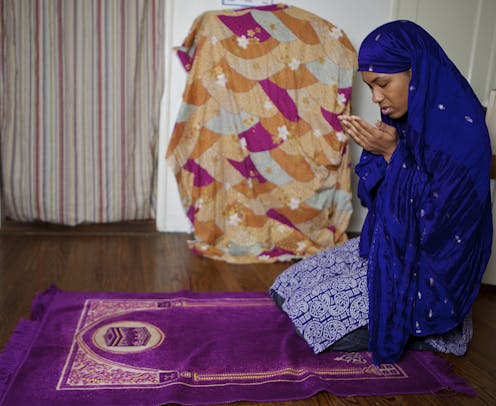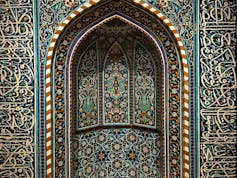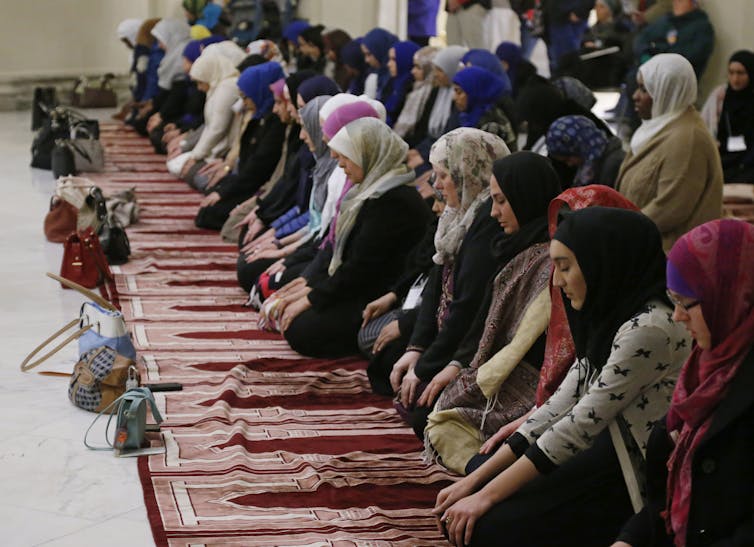What are Muslim prayer rugs?
Trump recently tweeted about prayer rugs being left along the border. Many may not know the role and history of Muslim prayer rugs and why they are not likely to be left behind.

In a recent tweet, President Trump stated that ranchers have been finding prayer rugs scattered along the U.S.-Mexico border. Late last year, he tweeted that “criminals and unknown Middle Easterners” were mixed in with the caravan heading to the U.S.
My research indicates that Islamophobia often targets visible signs of Muslimness, such as modest clothing like headscarves, as well as prayer rituals and mosques. This time it is the prayer rug.
These fearmongering tweets bear an uncanny resemblance to a 2018 action film, “Sicario: Day of the Soldado.” Its trailer shows a scene of a Muslim man praying and a row of prayer rugs at the border. In the movie, U.S. officials who find the rugs use them as “evidence” that Muslims are entering the U.S. illegally in order to expand the jurisdiction of the war on terror.
Other than these recent mentions, carpets found fame through Disney’s “Aladdin,” where they were imagined to have the power to fly. However, prayer carpets actually have a much more mundane daily use among Muslims.
Much more than a plain carpet
Ritual purity is extremely important for Muslim prayers practices. As Islamic studies scholar Marion Katz explains, prayer carpets provide a protective layer between the worshiper and the ground, protecting the clothing from anything on ground that is polluting.

Muslim carpets have been traditionally produced for centuries in Muslim majority regions, sometimes known as “the rug belt,” spanning from Morocco to Central Asia and northern India. There is a wide variety of designs and materials. Islamic art historian Walter B. Denny, in “How to Read Islamic Carpets,” explains the different materials and symbolism in weaves used in these carpets.
For example, it is common to find symbols such as the prayer niche, a recess in the wall indicating the direction of Mecca; also a lamp, which is a reference to God; as well as flowers and trees that symbolize the abundance of nature in God’s paradise.
Prayer carpets that are used in homes are generally sized for one individual. Those used in mosques are much bigger, often with a motif showing a row of arches to indicate where each worshiper should stand in prayer.

Islamic carpets have been popular for centuries in Europe and beyond, often picking up symbolism, social meaning and ways of being used. Islamic carpets were popular among the wealthy of Europe, displayed proudly on the floor of their living rooms and on the walls.
Carpets designs have come down through generations. Some depict simple geometric patterns in rough wool, while other are produced by professional artisans for the elite and show hunting scenes and elaborate scenes of paradise.
Different costs and forms of practice
Practices vary according to personal and sectarian preference among Muslims.
For everyday use, Muslims purchase simple prayer carpets, mass-produced in Turkey, throughout the Middle East and even China. For use outside, they often carry a thinner travel rug. There are also high-priced versions. An antique carpet was auctioned for US$4.3 million in 2009 and an Ottoman-era prayer rug sold for $30,000 in 2015.
Not all sects of Muslims use the prayer carpet. Shiite Muslims usually pray on a clay disk called a “turba” in Arabic and “mohr” in Persian. This disk is often made from soil from Karbala, the place of martyrdom of Hussein, Prophet Muhammad’s grandson in today’s Iraq, or another sacred site.
They often place the disk on top of a prayer carpet. When Shiites prostrate their foreheads on the floor during prayer, they want their forehead to be in contact with an organic material rather than the synthetic fibers of a carpet. So, depending on circumstance, they might also place any natural material such as a small straw mat where they pray.
It is highly unlikely for Muslims to leave behind their prayer rugs or to even carry one on a perilous journey through the harsh desert.
Rose S. Aslan does not work for, consult, own shares in or receive funding from any company or organization that would benefit from this article, and has disclosed no relevant affiliations beyond their academic appointment.
Read These Next
Indian protesters pull from poetic tradition to resist Modi’s Hindu nationalism
Thanks to a strong oral Urdu literary tradition in South Asia, poems from the past linger in the popular…
How Iran responds to Damascus attack could determine trajectory of conflict in the Middle East
Tehran has warned that no Israeli embassy is safe following deadly bombing of its mission in Damascus.
I spent a decade helping Afghan girls make educational progress − and now the Taliban are using thes
If the ban on girls’ education in Afghanistan persists, consequences could include higher rates of…




